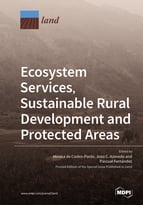Ecosystem Services, Sustainable Rural Development and Protected Areas
A special issue of Land (ISSN 2073-445X).
Deadline for manuscript submissions: closed (30 June 2021) | Viewed by 41490
Special Issue Editors
Interests: protected areas; ecosystem services; Multi-Criteria decision making (MCDM); data envelopment analysis (DEA); goal programming (GP)
Interests: forest landscape ecology; forest landscape sustainability; ecosystem services; sustainable forest bioenergy; mountain sustainability
Special Issues, Collections and Topics in MDPI journals
Special Issue Information
Dear Colleagues,
Enhancing social and economic development while preserving nature is one of the major challenges for humankind in the current century. The Millennium Ecosystem Assessment showed an alarming degradation of ecosystems and exacerbated poverty for many groups of people across the world due to unprecedented changes in ecosystems caused by human activities in the 20th century. Sustainable Rural Development is key to maintaining active local communities in rural and semi-natural areas, avoiding depopulation, and preserving high-ecological-value sites, including protected areas. Designation of an area as a ‘protected’ area is the first strategy applied to conserve biodiversity around the world, as it ensures the supply of ecosystem services. However, depending how it affects economic opportunities and the access to natural resources, it can either attract or repel human settlements. The convergence of development and conservation requires decision-making processes capable of aligning the needs and expectations of rural communities and the goals of biodiversity conservation. However, the complexity and multi-functionality of rural socioecological systems make decision-making in these areas difficult. Therefore, it is crucial to develop innovative strategies, approaches, methods, and models to jointly improve the welfare of rural communities and achieve the objectives of nature conservation. The purpose of this Special Issue is to invite academics and researchers to submit proposals for papers oriented to enhancing the sustainable rural development and protection of natural areas. Potential topics include, but are not limited to:
- evaluation methods and techniques for supporting choices in sustainable land planning in rural areas;
- criteria and indicators for sustainable rural development;
- criteria and indicators for monitoring ecosystem services in protected areas;
- innovative models for identifying and solving conflicts between groups of stakeholders;
- innovative tools for land planning and management in protected and other conservation areas;
- strategies for improving the sustainable supply of ecosystem services in rural areas; and
- protection, management, and safeguarding of natural areas.
Dr. Mónica de Castro-Pardo
Dr. Joao C. Azevedo
Dr. Pascual Fernández
Guest Editors
Manuscript Submission Information
Manuscripts should be submitted online at www.mdpi.com by registering and logging in to this website. Once you are registered, click here to go to the submission form. Manuscripts can be submitted until the deadline. All submissions that pass pre-check are peer-reviewed. Accepted papers will be published continuously in the journal (as soon as accepted) and will be listed together on the special issue website. Research articles, review articles as well as short communications are invited. For planned papers, a title and short abstract (about 100 words) can be sent to the Editorial Office for announcement on this website.
Submitted manuscripts should not have been published previously, nor be under consideration for publication elsewhere (except conference proceedings papers). All manuscripts are thoroughly refereed through a single-blind peer-review process. A guide for authors and other relevant information for submission of manuscripts is available on the Instructions for Authors page. Land is an international peer-reviewed open access monthly journal published by MDPI.
Please visit the Instructions for Authors page before submitting a manuscript. The Article Processing Charge (APC) for publication in this open access journal is 2600 CHF (Swiss Francs). Submitted papers should be well formatted and use good English. Authors may use MDPI's English editing service prior to publication or during author revisions.
Keywords
- sustainable rural development
- ecosystem services
- protected areas
- land use policy
- natural parks
- governance of socioecological systems
- human–nature conflicts








